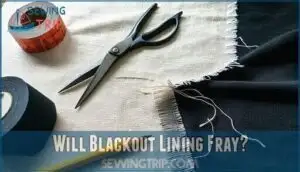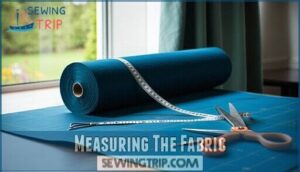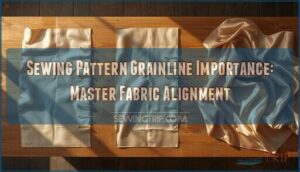This site is supported by our readers. We may earn a commission, at no cost to you, if you purchase through links.
 Yes, blackout lining requires hemming for best results.
Yes, blackout lining requires hemming for best results.
Without proper hemming, your fabric edges will fray and unravel, creating a messy appearance that shortens the lining’s lifespan.
You can hem blackout lining using a sewing machine for clean, professional edges or hand-stitch for more control.
The process involves folding the raw edge twice and securing it with straight stitches, which prevents fraying while maintaining the lining’s light-blocking properties.
This simple step is like an insurance for your window treatments—it’s a small effort that pays off big time.
The specific technique you choose depends on your skill level and available tools.
Table Of Contents
- Key Takeaways
- What Happens if Blackout Lining Isn’t Hemmed?
- Will Blackout Lining Fray?
- Will Hemming Blackout Lining Make It Last Longer?
- Methods of Hemming Blackout Lining
- Measuring The Fabric
- Sewing The Blackout Curtains
- Pressing The Curtains
- Sewing on The Tabs
- Hemming and Hanging The Curtains
- Frequently Asked Questions (FAQs)
- Conclusion
Key Takeaways
- You should hem blackout lining to prevent fraying and extend its lifespan, even though it’s naturally fray-resistant due to its tight weave and acrylic coating.
- You’ll get professional results using either machine hemming with a size 90/14 needle and long stitch length, or hand hemming with blind hem stitches for more control.
- You need to measure carefully and add 8 inches for bottom hems and 6 inches for side hems when calculating your fabric requirements to avoid running short.
- You must use low heat settings and pressing cloths when ironing blackout curtains to protect the foam backing from melting or becoming shiny.
What Happens if Blackout Lining Isn’t Hemmed?
When you skip hemming your blackout lining, you’re basically leaving the door open for several problems.
Fraying consequences become immediate as raw edges start to unravel, creating unsightly threads that compromise your curtain’s professional appearance. This unraveling leads to shape distortion, where your once-straight edges become wavy and uneven.
Raw edges unravel fast, turning your professional curtains into a frayed, wavy mess that screams amateur hour.
Light leakage becomes a real issue as frayed gaps allow unwanted brightness to seep through, defeating the blackout purpose entirely.
The appearance impact is significant—your carefully sewn curtains look unfinished and cheap. Without proper hemming, you’ll face lifespan reduction as the blackout lining deteriorates faster, requiring premature replacement of your sewing project.
Will Blackout Lining Fray?
Blackout lining won’t fray easily, but it’s not completely immune to edge damage.
The fabric composition of most blackout materials includes tightly woven fibers with an acrylic layer that creates natural fraying resistance.
This weave density makes the fabric more stable than regular curtain materials.
However, don’t let this fool you into skipping proper finishing.
While blackout lining has better edge durability than standard fabrics, repeated handling, washing, and time can still cause some unraveling.
The edges might develop loose threads or slight fraying, especially at stress points like corners.
Think of fraying resistance as a built-in safety net, not a guarantee.
Hemming your blackout lining provides an extra layer of protection for the fabric edges.
It’s like wearing a seatbelt – you mightn’t need it every time, but when you do, you’ll be glad it’s there.
Proper sewing techniques guarantee your curtains maintain their professional appearance and functionality for years.
Will Hemming Blackout Lining Make It Last Longer?
Yes, hemming blackout lining substantially extends its lifespan and improves overall performance.
When you hem your blackout lining, you’re creating a barrier that prevents fraying at the edges, which is where most fabric deterioration begins.
This fray prevention keeps the material intact longer, even with regular washing and handling.
Hemming also provides essential shape retention.
Without proper edge finishing, your lining can stretch unevenly or develop loose threads that compromise the curtain’s appearance and light-blocking effectiveness.
The hemming durability you achieve through proper sewing techniques means your curtains maintain their professional finish for years.
The lifespan extension gained from hemming is particularly valuable since blackout lining represents a considerable investment.
While blackout fabric naturally resists fraying better than regular materials, adding hems creates an extra layer of protection.
This simple step in fabric durability guarantees your window treatments continue blocking light effectively while looking polished.
Methods of Hemming Blackout Lining
When you decide to hem your blackout lining, you have two main options that will give you professional results.
You can use a sewing machine for quick, efficient hemming or choose hand sewing for smaller projects that need more precise control.
Sewing Machine Hemming
Machine hemming transforms your blackout lining project from tedious to efficient.
Your sewing machine handles heavy fabric weight while delivering consistent results that hand-sewing can’t match.
Blackout fabric can be tricky, so consider alternative pinning methods to avoid damage.
Set up your machine properly for professional outcomes:
- Stitch Length: Use longest setting available to prevent fabric puckering
- Needle Choice: Install size 90/14 or 100/16 for piercing dense material
- Thread Tension: Adjust to medium setting for balanced stitches
- Hemming Feet: Attach blind hem foot for invisible finishes
- Backstitching Technique: Secure each seam start and end point
This sewing for beginners approach guarantees your blackout lining stays put permanently.
Hand Hemming
Hand hemming blackout lining offers superior control for beginners learning sewing techniques.
Select sharp needles appropriate for your fabric weight, maintaining consistent thread tension throughout each stitch.
Popular hand stitch types include blind hem and slip stitch for invisible finishes.
Focus on securing seams properly and mastering corner techniques to prevent fraying.
This method guarantees precise results when hemming heavy blackout materials.
You can find the right hemming needle products for your project.
Measuring The Fabric
You’ll need precise measurements to determine the correct amount of blackout fabric for your curtain project.
Accurate calculations prevent waste and guarantee you have enough material for proper hems and fullness.
How Much Fabric Do You Need?
Proper yardage calculation starts with understanding fabric width requirements for your blackout lining project.
Standard fabric widths range from 45 to 60 inches, affecting how many panels you’ll need.
Consider the fullness factor – typically 1.5 to 3 times your window width for pleasing drape.
Don’t forget hem allowances when calculating total fabric needed.
Add 8 inches for bottom hems and 6 inches for side hems to your measurements.
Pattern matching requires extra fabric if you’re coordinating with existing decor.
Smart planning prevents costly mistakes and guarantees your hemming and sewing project succeeds beautifully.
To maximize light blockage, consider the outside mount method.
How to Calculate How Much Fabric is Needed?
Calculating fabric yardage starts with accurate measurement of your window dimensions. You’ll need to factor in hem allowances and the fullness factor for proper drape.
Here’s your step-by-step approach:
- Measure twice, cut once – Record window width and height precisely
- Add hem allowances – Include 8 inches for bottom hems, 3 inches per side
- Apply fullness factor – Multiply width by 1.5-2.5 for gathering
Pattern matching requires extra fabric for alignment. A fabric calculator online can simplify estimating material needs.
This yardage calculation method guarantees you won’t run short when hemming blackout lining.
Sewing The Blackout Curtains
Thread type matters more than you’d think when sewing blackout fabric.
Choose polyester thread for its durability – it’ll outlast cotton thread by years.
Your needle choice determines success or frustration.
Use a Teflon-coated needle, size 90/14 or 100/16, to glide through the plastic coating without creating snags.
Set your stitch length to 6 stitches per inch.
This longer setting reduces stress on the delicate blackout lining surface.
Fabric weight requires special handling during sewing blackout curtains.
Rest heavy panels on your bed or table to prevent stretching.
Use fabric clips instead of pins – those permanent holes from pinning won’t disappear.
Maintain consistent seam allowance throughout your project, typically 5/8 inch for professional results.
When hemming, sew the blackout lining slightly shorter than your main curtain fabric.
This prevents the lining from peeking out underneath your finished curtains.
Pressing The Curtains
Once you’ve finished sewing your blackout curtains, pressing becomes the vital step that transforms your project from homemade to professional-looking.
Set your iron to low or medium heat settings to protect the delicate blackout lining from damage. Always use pressing cloths as a barrier between your iron and the fabric – this prevents the foam backing from melting or becoming shiny. A great option is to use muslin cloth alternatives for this purpose.
Focus on seam pressing first, working from the inside out to create crisp, flat edges. For wrinkle removal, move your iron gently without applying excessive pressure. The three-pass blackout lining requires extra care during fabric maintenance, so test your heat settings on a small corner first.
Steam sparingly to avoid moisture damage to the foam layer. This careful pressing technique guarantees your hemming work looks polished and your curtains hang beautifully once installed.
Sewing on The Tabs
Four tabs per panel create the perfect balance for your blackout curtains.
Start by cutting your tab pieces to 4.5" x 6" dimensions, then fold each piece lengthwise with right sides together.
Sew down the lengthwise seam and press it open at the center back before turning right side out.
Tab placement requires precision – space your curtain tabs exactly 6 inches apart across the top edge.
Position each tab approximately 1 inch from the curtain’s top edge for ideal hanging.
This tab spacing guarantees even weight distribution and prevents sagging.
For tab reinforcement, use multiple rows of stitching when attaching tabs to your curtain.
Backstitch at both ends to prevent unraveling.
These sewing tips guarantee your tabs won’t fail under the weight of heavy blackout fabric.
Consider hidden tabs or alternative tabs like grosgrain ribbon for different aesthetic effects in your curtain sewing project.
Hemming and Hanging The Curtains
Once you’ve completed the blackout lining hemming, it’s time to hang your curtains and see your hard work pay off.
First, verify your rod placement is 4-6 inches above the window frame for ideal light blocking. Your curtain weight will be heavier than standard panels, so choose a sturdy rod that won’t bow under pressure.
When hanging, check that your fabric fullness creates gentle folds without bunching. The hem allowances you added should create clean, professional edges that don’t show the lining underneath.
For a professional touch, consider adding drapery weights to improve the drape. Test the curtains by closing them completely – proper hemming and hanging should eliminate light gaps at the bottom.
If you notice any issues with light blocking, adjust the curtain positioning or check that your easy sewing techniques created even hems. This final step transforms your curtain hemming project into functional window treatments.
Frequently Asked Questions (FAQs)
Do you need to hem blackout lining?
Like Goldilocks finding the perfect fit, you don’t technically need to hem blackout lining since it’s fray-resistant.
However, hemming creates a polished, professional look and prevents shifting, making your curtains last longer.
How do you shorten blackout curtains?
Measure your desired length, mark with fabric chalk, fold the hem twice for stability.
Then sew using a heavy-duty needle.
Cut excess fabric if needed, ensuring the blackout lining stays aligned.
Can I use hemming tape on blackout curtains?
Yes, you can use hemming tape on blackout curtains.
Choose fusible hemming tape designed for heavier fabrics.
It’s a quick no-sew alternative that works well with blackout material’s weight and thickness.
Does Blackout fabric fray?
Blackout fabric typically doesn’t fray much due to its tightly woven construction and acrylic coating layers.
However, cut edges can still unravel over time, so hemming provides extra security and a professional finish.
Can fusible tape replace traditional hemming methods?
Fusible tape offers a quick no-sew alternative to traditional hemming, creating clean edges without stitching.
You’ll simply iron the tape between fabric layers, though hand or machine hemming provides more durability for heavy blackout curtains.
What needle size works best for blackout fabric?
Sarah’s sewing machine struggled through thick blackout fabric until she switched needles.
You’ll need a size 90/14 or 100/16 needle for best results.
These sharp, strong needles handle the dense weave without breaking or skipping stitches.
Should lining be hemmed shorter than face fabric?
Hem your lining about half an inch shorter than the face fabric to prevent it from peeking out underneath.
This creates a clean, professional look while ensuring the lining stays hidden behind the main curtain fabric.
How do you prevent puckering when sewing blackout material?
Nothing ruins a perfect seam like fabric bunching up like an accordion.
Use consistent tension, a long stitch length, and rest heavy blackout material on a flat surface while sewing to prevent puckering.
Reorganizing the sewing process in this way will help to ensure a smooth and even finish.
Conclusion
Hemming protects your investment, prevents unsightly fraying, and guarantees your blackout curtains maintain their professional appearance for years.
Whether you’re hand-stitching for precision or using a machine for speed, this essential step transforms raw fabric edges into durable, finished seams.
Don’t skip this vital process—your window treatments deserve the extra attention.
With proper hemming techniques, you’ll create beautiful, long-lasting blackout curtains that block light effectively while looking professionally made throughout their extended lifespan, ensuring they remain a valuable investment and provide a durable solution.
- https://www.homedecgal.com/
- https://www.quartoknows.com/books/9781589239319/Singer-R-Sewing-Custom-Curtains-Shades-and-Top-Treatments.html
- http://www.roc-lon.com/company/add_performance.html
- https://www.onlinefabricstore.com/makersmill/how-to-pick-drapery-lining/?srsltid=AfmBOoqIL8X-gpYcWlM_j4HA_gLE8vryRIWCHU4K5A3L9MJXghRI2vTh
- https://twinsnneedles.com/2019/07/26/sewing-blackout-lined-curtains-some-tips/












